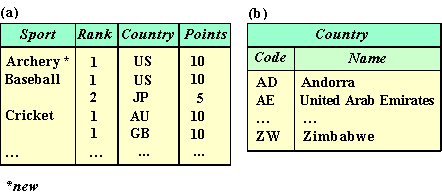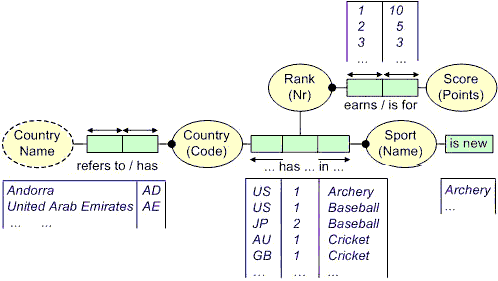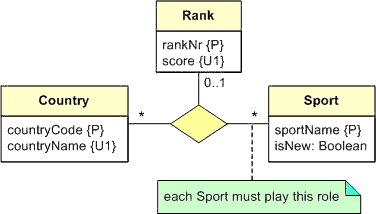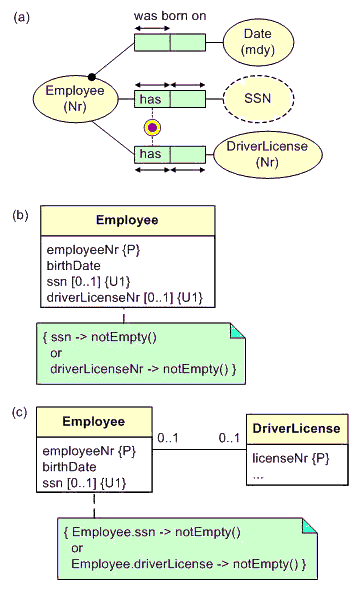Verbalizing Business Rules (Part 5)
Business rules should be validated by business domain experts and hence specified using concepts and languages easily understood by business people. This is the fifth in a series of articles on expressing business rules formally in a high-level, textual language.
The first article[3] discussed criteria for a business rules language, and verbalization of simple uniqueness and mandatory constraints on binary associations. The second article[4] examined hyphen-binding and verbalization of internal uniqueness constraints that span a whole association, or that apply to n-ary associations. The third article[5] covered verbalization of basic external uniqueness constraints. The fourth article[6] considered relational-style verbalization of external uniqueness constraints involving nesting or long join paths, as well as attribute-style verbalization of uniqueness constraints and simple mandatory constraints.
This article discusses further aspects of verbalizing mandatory constraints. In particular, it considers verbalization of mandatory constraints on roles of n-ary associations and disjunctive mandatory constraints (also known as inclusive-or constraints) over sets of roles.
Verbalization of mandatory constraints on roles of n-ary associations
Consider a business that tracks for each sport the current standing of the top-ranked countries in those sports. Two sample reports from this business domain are shown in Figure 1. The domain expert might verbalize the facts on the top row of report (a) thus: Archery is new (it's the first year it's included in the rankings); the US ranks first in archery and scored 10 points for that. As modelers, we suspect that Rank functionally determines Points in the population and verify this with the domain expert. We now rephrase the information into elementary facts: the Sport named 'Archery' is new; the Country with code 'US' has the Rank numbered 1 in the Sport named 'Archery'; the Rank numbered 1 earns the Score 10 points.

Figure 1. Sample reports from a business that tracks leading sport performances.
Similarly, the top row of the reference table shown in report (b) may be verbalized as: the Country with code 'AD' has the name 'Andorra.' If reference schemes are agreed to up front (e.g., Sports are identified by name), these verbalizations may be abbreviated (e.g., the Sport 'Archery' is new).
Once the domain expert agrees with the verbalization, we abstract from the fact
instances to the fact types and add constraints, validating these with the domain
expert by verbalizing them in natural language and checking them against sample fact
populations. An ORM conceptual schema for this example, together with sample
fact populations, is shown in Figure 2. There is one unary fact type:
Sport is new, two binary associations: Country has CountryName, and
Rank earns Score, and one ternary association: Country has Rank in Sport.
A sample row for Rank 3 has been added to illustrate the mandatory and optional
nature of the roles played by Rank (a rank's score must be recorded even if no country
achieves this rank -- this rule was not evident from the original sample but is obtained
when checking constraints with the domain expert). The uniqueness constraint
on the ternary association may be verbalized as "Given
any Country and Sport, that Country has at most one Rank
in that Sport," or more briefly as "Each Country has at most one Rank in each
Sport." This constraint is satisfied by the sample population,
where the Country-Sport pairs are unique.

Figure 2. An ORM schema for Figure 1, with sample fact populations.
The uniqueness and mandatory role constraints on the binary fact types are easily verbalized using patterns discussed in earlier articles. Of special interest here is the mandatory constraint on the last role of the ternary fact type. This constraint may be verbalized as follows.
For each Sport, some Country has some Rank in that Sport.
As usual, 'Given any'
may be used instead of 'For each,'
and 'at least one' or 'a' may be used instead of 'some.' In cases where the
same object type plays more than one role in the fact type, subscripts may be used
to distinguish the different role players (as discussed in earlier articles).
An ORM diagram shows only one predicate reading for each n-ary association, and
this reading is understood to go from one end to the other (left-to-right or top-to-bottom,
unless prepended by '<<'
which reverses the reading direction). However, predicate readings may be supplied
in the textual version of the schema for any permutation of the roles, and these
readings may be used in alternative verbalizations. For example, the ternary
fact type Country has Rank in Sport
in Figure 2 may be given alternative readings such as Rank
in Sport is held by Country, or Rank
is held by Country in Sport, or Sport
has Rank held by Country. If the mandatory constraint applies
to the first role of such a reading, then the mandatory constraint can be
verbalized a little more tidily. For example, the constraint considered earlier
may be verbalized thus:
Each Sport has some Rank held by some Country.
As industrial ER is restricted to binary associations, I'll ignore it for this example. UML does support n-ary associations but has problems with declaring mandatory constraints on them. For example, suppose we model the example under discussion using the UML class diagram shown in Figure 3. As discussed in earlier articles, '{P}' and '{U1}' are non-standard extensions I use to declare preferred identifier and uniqueness constraints on UML attributes.

Figure 3. UML schema for Figure 1.
The Country-Sport uniqueness constraint in the ORM ternary is modeled in UML using the 0..1 multiplicity constraint on the role played by Rank. The '*' multiplicities indicate the absence of any other uniqueness constraint. However, the simple mandatory role constraint on Sport cannot be expressed by a multiplicity constraint in UML. It might be thought that this constraint can be expressed by changing the multiplicity on the Country role to 1..*. But this would mean that each Sport-Rank pair formed from the populations of Sport and Rank must be associated with at least one country. But this is not true, since the role played by Rank is optional. For example, the pairs Archery-2 and Archery-3 have no associated country in the sample population.
In UML, a multiplicity constraint on a single role indicates the number of instances (playing that role) that are associated (in the association) with each tuple from the Cartesian product of the populations of the other n-1 roles in the association (where n > 1). Although this works fine for binary associations, UML multiplicity constraints can specify mandatory role constraints in an n-ary association if and only if at least n-1 of the association roles are mandatory. If fewer than n-1 roles are mandatory, this cannot be captured by a multiplicity constraint. The example under discussion is such a case. In Figure 3, the required mandatory constraint is captured informally in a note. Alternatively, this constraint could be declared formally in OCL.[9]
Even for n-ary associations where n-1 or n roles are mandatory, UML cannot express these mandatory constraints graphically without asserting a much stronger constraint (each tuple in the unrestricted Cartesian product of the other role populations must play in the association). While this strong constraint does imply the individual mandatory constraints, it is likely to be far too strong in practice except for pathological cases, or for cases where populations of the object types are tightly restricted by value constraints. In some cases, we can cater for fewer than n-1 mandatory roles in UML by binarizing the n-ary, but as explained elsewhere[2] this leads to other problems, so does not provide a satisfactory solution.
Note that verbalizing any constraint in relational style on an n-ary association is ruled out for UML, as UML has no way of depicting the role order in which any n-ary association reading is to be understood. A verbalization is possible, however, so long as we have a name for the association. For example, if we assign the name 'Ranking' to the ternary association in Figure 3, the mandatory constraint may now be verbalized thus:
Ranking is mandatory for Sport.
Verbalization of inclusive-or (disjunctive mandatory) constraints
Consider the employee report extract shown in Table 1. The '?' mark denotes a null value. Employees are identified by their employee number, and their birthdate must be recorded. In addition, each employee must have a social security number (SSN), or a driver license number (possibly both -- this restriction is an example of an inclusive-or constraint (or disjunctive mandatory constraint).
Table 1. Extract of Employee details
EmployeeNr
BirthDate
SSN
DriverLicenseNr
001
01/01/1970
539-01-2345
?
002
11/30/1980
?
170001111
003
01/01/1970
123-45-6789
160101234
...
...
...
...
Inclusive-or constraints often occur in practice and are supported by ORM's graphical notation. UML and commercial versions of ER include graphical notations for exclusive-or constraints (to be covered in a later article) but not inclusive-or constraints -- in which case they need to be added textually, either informally as a note or formally in a constraint language such as OCL. Whichever modeling notation is used, inclusive-or constraints should be verbalized in a high-level language.
Figure 4(a) models this example in ORM. Here
DriverLicense
is modeled as an entity type, allowing other information to be recorded about it
if desired (e.g., license class, issue date, expiry date). The inclusive-or
constraint is depicted by the circled dot, connected to the roles to which it applies.
The circled dot is just a mandatory constraint dot, and connecting it to two roles
indicates that at least one of these roles must be played by each instance in the
population of the Employee entity
type. In other words, the logical disjunction of these roles is mandatory for
Employee (hence the name 'disjunctive
mandatory constraint').

Figure 4. Inclusive-or constraint in ORM and UML.
The usual ORM verbalization of this constraint is:
Each Employee has some SSN or has some DriverLicense.
This can be rendered more naturally by using 'a'
or 'an' instead of 'some' and by eliding the second
occurrence of 'has,' to give:
Each Employee has an SSN or a DriverLicense.
If the predicate names differ, however, both must be included, as in the first
version. The verbalization would be even better if the full name 'SocialSecurityNumber' had been used instead of
'SSN' in the model -- in this
case, 'a' would be used
instead of 'an' as the
rendition of the existential quantifier.
Figure 4(b) models the example in UML, treating the driver license fact type as an attribute of Employee. In this case, the constraint is formally captured in text as an OCL expression. Figure 4(c) provides an alternative UML model, using a DriverLicense class to allow further details to be stored about driver licenses. Again, an OCL expression is used to capture the constraint formally. Because of the mathematical nature of OCL syntax, a high-level verbalization is still required for validating the constraint with non-technical domain experts. In this case, a relational-style verbalization may be used, using the attribute or role names as property names, with a 'has' predicate assumed for each. For Figure 4(b) this yields:
Each Employee has some ssn or some driverLicenseNr.
and for Figure 4(c), we have:
Each Employee has some ssn or some driverLicense.
Again, 'a' or 'an' may be used instead of 'some.' Inclusive-or constraints
may apply to a set of two or more roles, so long as those roles are played by compatible
object types. For more complex cases involving roles with no starting predicate
reading, and possibly from n-ary fact types, a more generic pattern may be used.
For example: each Employee plays
at least one of the following roles: Employee
has SSN; Employee has DriverLicense.
That completes our coverage of verbalization of uniqueness and mandatory constraints. The next article discusses verbalization of value constraints and set-comparison (subset, equality, and exclusion) constraints.
References
[1] T.A. Halpin. Information Modeling and Relational Databases. Morgan Kaufmann, San Francisco, 2001.
[2] T.A. Halpin. "Supplementing UML with concepts
from ORM," Unified Modeling Language: Systems Analysis, Design
and Development Issues, eds. K. Siau & T. Halpin, Idea Group Publishing,
Hershey, PA, USA, 2001, pp. 168-185. ![]()
[3] T.A. Halpin. "Verbalizing Business Rules
(part 1)," Business Rules Journal, Vol. 4, No. 4 (April 2003).
URL: http://www.BRCommunity.com/a2003/b138.html ![]()
[4] T.A. Halpin. "Verbalizing Business Rules
(part 2)," Business Rules Journal, Vol. 4, No. 6 (June 2003). URL: http://www.BRCommunity.com/a2003/b152.html ![]()
[5] T.A. Halpin. "Verbalizing Business Rules
(part 3)," Business Rules Journal, Vol. 4, No. 8 (August 2003).
URL: http://www.BRCommunity.com/a2003/b163.html ![]()
[6] T.A. Halpin. "Verbalizing Business Rules
(part 4)," Business Rules Journal, Vol. 4, No. 10 (October 2003).
URL: http://www.BRCommunity.com/a2003/b172.html ![]()
[7] T.A. Halpin, K. Evans, P. Hallock, & B. MacLean. Database Modeling with Microsoft Visio for Enterprise Architects. Morgan Kaufmann, San Francisco, 2003.
[8] Object Management Group. UML 2.0 Infrastructure. Object Management Group, 2003. URL: http://www.omg.org/uml
[9] Object Management Group. UML 2.0 Object Constraint
Language. Object Management Group, 2003. URL: http://www.omg.org/uml ![]()
# # #
About our Contributor:
Online Interactive Training Series
In response to a great many requests, Business Rule Solutions now offers at-a-distance learning options. No travel, no backlogs, no hassles. Same great instructors, but with schedules, content and pricing designed to meet the special needs of busy professionals.











How to Define Business Terms in Plain English: A Primer
How to Use DecisionSpeak™ and Question Charts (Q-Charts™)
Decision Tables - A Primer: How to Use TableSpeak™
Tabulation of Lists in RuleSpeak®: A Primer - Using "The Following" Clause
Business Agility Manifesto
Business Rules Manifesto
Business Motivation Model
Decision Vocabulary
[Download]
[Download]
Semantics of Business Vocabulary and Business Rules